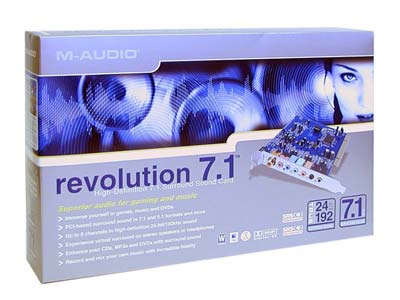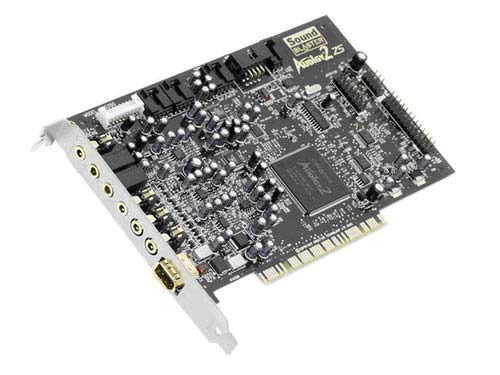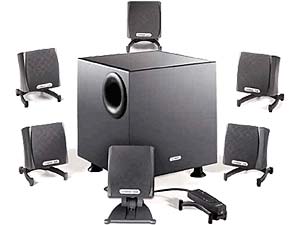High End Buyer's Guide - September 2004
by Wesley Fink on August 30, 2004 12:22 AM EST- Posted in
- Guides
Sound Card
Recommendation: M-Audio Revolution 7.1Price: $94
Some tastes run more to sound quality than gaming on the PC and we would recommend the M-Audio Revolution 7.1 for those buyers.

At about the same price as a retail Audigy 2 ZS, the M-Audio brings you the superb Envy 24HT chipset. This is the same family chipset that powers other well-regarded audio cards like the more expensive Terratec, and this is the full-blown 24/192 version. With a S/N ratio of more than 107db, and 24-bit/192kHz payback on all channels, the Revolution 7.1 is a card that will compare well to the best from anyone. The IO capabilities are also stellar, with both 7.1 speaker outputs and coaxial SPDIF. Even the microphone and analog inputs have a very respectable recording specification of 24-bit/96 kHz, and the Analog to Digital S/N, which most cards won't even quote, is a silent 100db.
If your audio goals are even more ambitious in a high end system, M-Audio specializes in cards to satisfy a home studio user. Recommended cards included the M-Audio Audiophile 24/96 with pro-grade A/D converters and a 4-in/4-out gold-plated IO cable for about $150, and the whole Delta line with expanded inputs and outputs up to 10 in and 10 out - and still under $300.
As we've said before, there are people who don't need this kind of audio processing power - even on a high-end system. For those users, we simply suggest that you use your motherboard's onboard sound controller. On-board audio solutions are becoming increasingly capable, with recent on-board chips capable of 7.1 audio and high-definition audio. Some people could care less about their system's sound as long as it supports their applications and there isn't any interference or crackling. If that description fits you to a tee, then use the onboard sound controller and forget about adding an audio card.
Alternative: Creative Labs Sound Blaster Audigy 2 ZS (7.1) retail
Price: $90
While the Sound Blaster Audigy 2 series may not be the best performing audio cards that you can buy, it is hard to argue with their universal compatibility as the standard for sound in computer gaming.

If you're a big gamer, then the top choice for a sound card is the Audigy 2. The Audigy 2 ZS is also a good card for those who love watching Dolby Digital DVD movies, or for someone who just wants decent quality sound. This version of the Audigy 2 supports 8 channels of sound and will deliver a great listening experience in any game, especially ones that support the Audigy 2's special features, like EAX. Simply pair the Audigy 2 with the right set of speakers and you'll have the necessary tools for an exceptional listening experience. Other special Audigy 2 features include 24/96 analog playback and recording, and "add-ons" like FireWire.
The Audigy 2 ZS differs from the regular OEM Audigy 2 mainly in its support of 7.1 channels of sound instead of 6.1. The benefit of going to 7.1 isn't really all that huge, as there's a point that you reach where continually adding more channels yields diminishing returns; that is, your surround sound experience doesn't get a whole lot better going from 6.1 to 7.1 channels, or for that matter, 5.1 to 7.1 channels, depending on how sensitive your ears are. The Audigy 2 ZS is also a retail package instead of OEM, meaning you get additional bundled features, such as video games and a FireWire header.
Speakers
Recommendation: Klipsch Pro Media Ultra 5.1 speakersPrice: $357 shipped

There will probably be some flak with recommending 5.1 speakers with a 7.1 audio card. If you are looking for 7.1 speakers, then neither of our recommended speakers or our alternative recommendation will provide that feature. However, our recommended audio cards will do a wonderful job in powering either of our recommended speaker systems. The Klipsch Pro Media Ultra 5.1 speakers are recommended for one simple reason - they sound better than any other speakers that we have listened to on a computer. When we find 7.1 speakers that sound just as good, they will get our recommendation.
Some computer components become almost legendary, and if you will check out any Forum discussions of speakers, you will find the Klipsch mentioned with reverence. Klipsch is a well-known audiophile speaker manufacturer, but that does not always translate into great performance with powered speakers. The Pro Media 5.1 system works very well, and typical Klipsch, they even quote honest Total Harmonic Distortion in their specifications. Those accustomed to reading specs from a typical set of Asian speakers will not be impressed with 25-20000 +/- 5db for frequency response, or THD specifications of "per Satellite: 60watts/ channel@=‹1% THD,100Hz - 1,000Hz; Subwoofer: 170watts@=‹3% THD, 40Hz - 100Hz". However, audio enthusiasts will likely find the honest ratings and superb sound a refreshing change from the usual hype that goes with computer speakers. The Klipsch also includes a remote control for the speaker system "power box".
Alternative: Creative Labs Megaworks THX Certified 6.1 speakers
Price: $248 shipped

This speaker system provides 6.1 output and is an excellent value at a delivered price of $248. The sound is quite outstanding, but not quite the equal of the more expensive Klipsch Pro Media in our opinion. If you do decide to buy the Creative Megaworks, however, you will not be disappointed, with features and specifications of:
- 6.1 surround sound
- 99 dB signal to noise ratio
- 150W subwoofer
- 70W per satellite and 75W for the center
- Positional audio support.
If you absolutely have to have 7.1 support, then the Creative Gigaworks 7.1 speakers at about $426 (delivered) is available. We haven't auditioned the Gigaworks yet, but it will have to provide something that we have not seen in other 7.1 systems in order to beat the pure performance of the Klipsch Pro Media, which even costs less. No one would believe that there are speakers more expensive than Klipsch, but in this case, there really are more expensive computer speaker systems.
If you cannot find the lowest prices on the products that we've recommended on this page, it's because we don't list some of them in our RealTime pricing engine. Until we do, we suggest that you do an independent search online at the various vendors' web sites. Just pick and choose where you want to buy your products by looking for a vendor located under the "Vendor" heading.










53 Comments
View All Comments
Avalon - Tuesday, August 31, 2004 - link
#30, the AMD system should be somewhat faster in gaming for you. As for 3D studio max, I'm not sure which.stevennoland - Monday, August 30, 2004 - link
The vid card price list does not include the X800 XT! What gives? I've tried to find them, but I'm really beginning to belive they don't exist.stevennoland - Monday, August 30, 2004 - link
jjkusaf - Monday, August 30, 2004 - link
oh...and would an Intel system be better for gaming and 3D Studio Max?jjkusaf - Monday, August 30, 2004 - link
OK...first of all thanks for taking your time in writing this guide.I am in the market of building a new computer and will pretty much use this guide to help make my decisions. My computer will primarily be used for gaming (Doom3, N2003, etc) and 3D Studio Max.
My first question is about the CPU cooler. I take it that the stock cooler was used (I do not intend on overclocking)? I do not intend on buying the FX...but just the plain ol' AMD 64 3800. If the stock cooler is not recommended...then what cooler is?
Also...any advantages of the N-Force3 over the Via chipset...and vice versa.
Thanks for the write up!
Wesley Fink - Monday, August 30, 2004 - link
#25 - As was stated on the last page (Final Words) of the Geil Ultra X 3200 review, the Geil tops out around 466 on AMD Athlon 64. That is why we selected a Micron chip memory for the A64 in the Guide.#26 - typo fixed.
gherald - Monday, August 30, 2004 - link
The mid-range system from last month came to just over $1000. Now you are recommending a $3600 system as "high-end"C'mon Anand, that's too big of a price step. Three and a half "mid-range" systems for the price of one "high-end" ?!?
There should be a guide at around the $2000-2300 mark for this to be balanced.
danidentity - Monday, August 30, 2004 - link
Another small typo,Page 6, Storage:
"Anand has shown that there is little performance advantage to SATA 1, but striping is still useful for improving boot times."
I believe that is supposed to say "little performance advantage to RAID 0", as the link points to a RAID 0 article.
Andrevas - Monday, August 30, 2004 - link
I'm surprised the OCZ Powerstream 520W wasn't chosen for both systems, IMO it is the best power supply, period.And I'd like to know how well the new Geil Ultra X DDR400 sticks fair with the AMD 64 platforms in OCing since they were able to hit DDR561 in your review on an Intel platform.
Plus no mentioning of the Logitech Z680s?
Other then those issues, I think the components chosen were great except for the case, but that's more of a matter of personal interest.
Wesley Fink - Monday, August 30, 2004 - link
#14 and #21 - That sentence was a cut and paste error and has been corrected on the AGP video page. The timeline for 925X/775 has also been updated by removing the time reference.